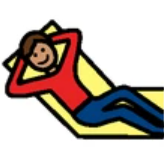Tilt-in-space is one of the most important functions of your wheelchair.
It is important to tilt your chair back a number of times throughout your day.
Tilting back is a safe thing to do.
Your chair has been designed to do this without tipping over backwards.






